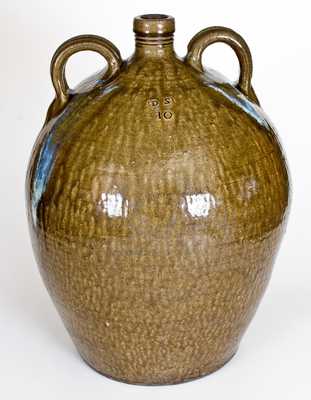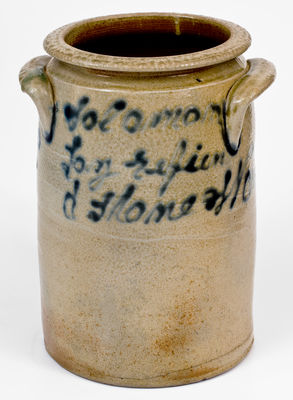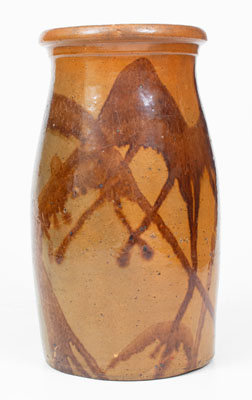Outstanding Salt-Glazed Stoneware Lidded Sugar Bowl with Incised Heron Eating Insect Decoration, attributed to Chester Webster, Randolph County, NC, circa 1855, ovoid form with tooled shoulder, flared collar, and applied strap handles, resting on three applied triangular feet; decorated on the front with an elaborate incised design of a heron with wide, impressed eye and profuse feather detail, attempting to devour flying insect. Reverse with incised anthemion design. Surface dipped in reddish-brown iron slip and decorated with brushed cobalt slip to the heron and floral motifs, a band of cobalt around the shoulder, cobalt dashes along the handles, and highlights to the handle terminals. Includes original slightly-domed lid with flattened knob and original pierced hole. This sugar bowl's extraordinary incised decoration and stylish construction rank it among the finest salt-glazed stoneware examples of the form produced in the American South. Its iron-dipped surface dates it to Webster's "middle period" of production during the mid 19th century. Its wonderful open-handled form with tripod base is distinctly regional, used by Webster and members of the Craven family in Randolph County. Webster's involvement at the pottery of his neighbor, Bartlett Yancy Craven, likely resulted in an exchange of ideas between both families. A cobalt-decorated sugar bowl of closely-related form, dated 1853 and attributed to the Craven family, was sold in Crocker Farm's November 19, 2021 auction, lot 7. The only Webster family sugar bowl that we are aware of, it is also one of only a few Chester Webster pieces known depicting the potter's prized heron motif. Bowl with several rim chips and a 1" hairline from rim. A 1 1/4" loss to lid and a 7/8" chip to underside of lid along edge. Provenance: Previously descended in the family of William Craven. H (including lid) 5".





















